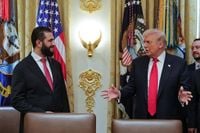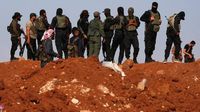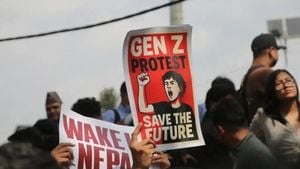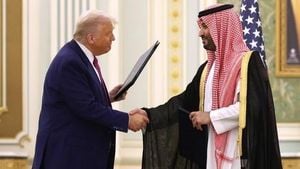In what can only be described as a stunning reversal of fortune, Syria has emerged from decades of international isolation in 2025, thrust into the global spotlight by a regime change that toppled the Assad dynasty and ushered in a government led by former Hayat Tahrir al-Sham (HTS) leader Ahmed al-Sharaa. The new administration, born from the ashes of civil war and sectarian strife, now faces the daunting challenge of forging unity at home while courting acceptance abroad—a balancing act fraught with both hope and peril.
The seismic shift began in December 2024, when Bashar al-Assad’s long-standing regime collapsed and HTS fighters took control of Damascus and the iconic People’s Palace. As reported by Al Arabiya English, Ahmed al-Sharaa swiftly assumed the presidency, appointing trusted confidant Asaad al-Shaibani as foreign minister. In a bold move, HTS and other armed groups were dissolved, with many of their members integrated into a transitional government that now helms Syria’s future.
This new government wasted no time signaling its intent to the world. Al-Shaibani embarked on a whirlwind diplomatic tour in November 2025, visiting Washington, DC, London, and planning a subsequent trip to China. His agenda: to drum up economic cooperation, attract investment, and, crucially, to press for the removal of sanctions that had long strangled the Syrian economy. Former Syrian ambassador Sami Khiyami told Al Arabiya English that Damascus is committed to a Syria with “no enemies,” emphasizing the administration’s diplomatic outreach as a key to national renewal. Khiyami noted, “The foreign minister will express the administration’s true hopes and plans.”
On November 12, al-Shaibani landed in London, marking the first official visit by a Syrian government official since the restoration of diplomatic ties. He immediately met with the British-Syrian community at the Intercontinental hotel, a gesture mirrored during his earlier visits to the United States. The next day, he raised the Syrian flag over the embassy in London—a potent symbol of renewed relations and, as former British ambassador Simon Collis described, “an important step toward re-establishing the bilateral relationship.”
Later that day, al-Shaibani attended a panel at Chatham House, where he described his meeting with UK Foreign Secretary Yvette Cooper as “successful,” declaring, “The relationship between the two nations is a friendship that is deep on the humanitarian and economic level.” He called on both governments to “utilize the historic opportunity in Syria.”
Britain’s rapprochement with Syria has been swift. Diplomatic ties, severed in 2012 after Assad’s brutal crackdown on dissent, were formally restored in July 2025 when then-Foreign Secretary David Lammy visited Damascus to meet President al-Sharaa. The British government, in a series of moves throughout the year, lifted sanctions on Syria’s defense and interior ministries, unfroze assets of financial bodies previously linked to the Assad regime, and, notably, in October, removed HTS from its list of proscribed terrorist organizations. This, London said, “will mean closer engagement with the new Syrian government.”
Across the Atlantic, the United States has also shifted gears. President al-Sharaa’s historic visit to the White House on November 10, 2025—the first ever by a Syrian leader since the country’s independence—was followed by President Donald Trump announcing a six-month suspension of US sanctions. Trump expressed a desire to see Syria “become a country that is very successful.” The move, while welcomed by Damascus, has drawn scrutiny from human rights advocates wary of trading economic relief for unfulfilled promises of reform.
One such voice is Nuri Kino, founder of the international advocacy group A Demand for Action (ADFA), who testified at a virtual hearing of the US Commission on International Religious Freedom (USCIRF) on November 13. Kino painted a grim picture of Syria’s Christian minorities, recounting the June 22 attack on the Greek Orthodox Mar Elias Church in Daramsuq—the deadliest assault on Christians since the 1860 Damascus Massacre. A teenage girl named Maryana was among those killed, her funeral becoming a symbol of the ongoing “ethno-religious cleansing” of Syria’s ancient minorities. “At her funeral, her mother held her hand through the coffin window as church bells tolled,” Kino said. “Friends and family threw sweets over her coffin—a wedding tradition for the bride she would never become.”
Kino warned that the fall of Assad and the dissolution of HTS have not brought an end to violence against Christians. “The destruction of churches, the kidnappings, the intimidation—it did not end in December,” he told USCIRF commissioners. He urged Washington to tie any easing of sanctions to measurable benchmarks for religious freedom, verified by independent monitors. “Speeches don’t stop emigration,” Kino cautioned. “Christians refuse to abandon 2,000 years of faith and memory in their beloved motherland. But fear and hopelessness are pushing them to leave.” He called for increased funding for minority-led relief organizations, protection of historic Christian sites, and the appointment of a special envoy for religious freedom in Syria. “These are the minimum steps required to stop a 2,000-year-old community from disappearing on our watch.”
While the new Syrian administration is eager to project an image of unity and inclusiveness, the reality on the ground remains fraught. In July 2025, the southern province of Suwayda was rocked by sectarian violence, triggered by the abduction of a Druze truck driver. The ensuing chaos drew in Bedouin tribal fighters and government forces, who were accused by many Druze of siding with the Bedouins. Hundreds of civilians, mostly Druze, were killed—many at the hands of government fighters. According to Judge Hatem Naasan, head of the committee investigating the violence, members of the security and military services found to have committed violations have been detained. “Videos posted on social media clearly showed faces, and they were detained by the authorities concerned,” he said. Naasan also confirmed that some foreign fighters had entered Suwayda and were being questioned, though none were members of the Syrian armed forces.
The violence in Suwayda drew international attention, with Israel launching air strikes on Syrian government forces in the province and even striking the Ministry of Defence in Damascus. Israel claimed its intervention was to protect the Druze. In the aftermath, calls for greater autonomy—or even partition—have emerged from within Suwayda, underscoring the persistent fractures in Syrian society.
Despite these internal challenges, President al-Sharaa’s efforts to reintegrate Syria into the international community have yielded tangible results. In September 2025, he became the first Syrian leader in six decades to address the United Nations General Assembly, and the lifting of sanctions by both the US and European Union has opened the door for much-needed Gulf Arab investment to flow into the country’s battered economy. Yet, as the government seeks to unify a nation scarred by 14 years of civil war, the fate of its minorities—and the promise of true reconciliation—remain uncertain.
For Syrians, the future hangs in the balance: a nation at a crossroads, striving for peace and dignity, yet still haunted by the ghosts of its past.





